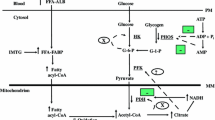Abstract
Organisms often shown enhanced growth during recovery from starvation, and can even overtake continuously fed conspecifics (overcompensation). In an earlier paper (Ecology 84, 2777–2787), we studied the relative role played by hyperphagia and resource allocation in producing overcompensation in juvenile (non-reproductive) animals. We found that, although hyperphagia always produces growth compensation, overcompensation additionally requires protein allocation control which routes assimilate preferentially to structure during recovery. In this paper we extend our model to cover reproductively active individuals and demonstrate that growth rate overcompensation requires a similar combination of hyperphagia and allocation control which routes the part of enhanced assimilation not used for reproduction preferentially towards structural growth. We compare the properties of our dynamic energy budget model with an earlier proposal, due to Kooijman, which we extend to include hyperphagia. This formulation assumes that the rate of allocation to reserves is controlled by instantaneous feeding rate, and one would thus expect that an extension to include hyperphagia would not predict growth overcompensation. However, we show that a self-consistent representation of the hyperphagic response in Kooijman’s model overrides its fundamental dynamics, leading to preferential allocation to structural growth during recovery and hence to growth overcompensation.
Similar content being viewed by others
References
Blum, W. F. (1997). Leptin: the voice of the adipose tissue. Hormone Res. 48, 2–8.
Bradley, M. C., N. Perrin and P. Calow (1991). Energy allocation in the clodoceran Daphnia magna Strauss under starvation and refeeding. Oecologia 86, 414–418.
Broekhuisen, N. W., W. S. C. Gurney, A. Jones and A. Bryant (1994). Modelling compensatory growth. Funct. Ecol. 8, 770–782.
Bull, C. D. and N. B. Metcalfe (1996). Regulation of hyperphagia in response to varying energy deficits in over-wintering juvenile Atlantic salmon. J. Fish Biol. 20, 498–510.
Friedman, J. M. (1998). Leptin, leptin receptors and the control of body weight. Nutr. Rev. 56, 38–46.
Fujiwara, M., B. E. Kendal and R. M. Nisbet (2004). Growth autocorrelation and animal size variation. Ecol. Lett. 7, 106–113.
Gurney, W. S. C., W. Jones, A. R. Veitch and R. M. Nisbet (2003). Resource allocation, hyperphagia and compensatory growth in juveniles. Ecology 84, 2777–2787.
Gurney, W. S. C. and R. M. Nisbet (1998). Ecological Dynamics, New York: Oxford University Press.
Hayward, R. S., D. B. Noltie and N. Wang (1997). Use of compensatory growth to double hybrid sunfish growth rates. Trans. Am. Fisheries Soc. 126, 316–322.
Jobling, M. and S. J. S. Johansen (1999). The lipostat, hyperphagia and catch-up growth. Aquaculture Res. 30, 473–478.
Kennedy, G. C. (1953). The role of depot fat in hypothalmic control of food intake in the rat. Proc. R. Soc. B 140, 578–592.
Kooijman, S. A. L. M. (1993). Dynamic Energy Budgets in Biological Systems, Cambridge: Cambridge University Press.
Kooijman, S. A. L. M. (2000). Dynamic Energy and Mass Budgets in Biological Systems, Cambridge: Cambridge University Press.
Miglavs, I. and M. Jobling (1989a). Effects of feeding regime on food consumption, growth rates and tissue nucleic acid in juvenile Arctic charr, Salvelinus alpinus with particular reference to compensatory growth. J. Fish Biol. 34, 937–957.
Miglavs, I. and M. Jobling (1989b). The effects of feeding regime on proximate body composition and patterns of energy deposition in juvenile arctic charr, Salvelinus alpinus. J. Fish Biol. 35, 1–11.
Muller, E. and R. M. Nisbet (2000). Survival and production in variable resource environments. Bull. Math. Biol. 62, 1163–1190.
Nisbet, R. M., E. B. Muller, K. Like and S. A. L. M. Kooijman (2000). From molecules to ecosystems through dynamic energy budgets. J. Anim. Ecol. 69, 913–926.
Russell, N. R. and R. J. Wooton (1992). Appetite and growth compensation in the European minnow, Phoxinus phoxinus, following short periods of food restriction. Environ. Biol. Fishes 34, 277–285.
Weatherly, A. H. and R. W. Gill (1981). Recovery growth following periods of restricted rations and starvation in rainbow trout Salmo gairdneri Richardson. J. Fish Biol. 18, 195–208.
Weigle, D. S. (1994). Appetite and the regulation of body composition. FASEB J. 8, 302–310.
Wilson, P. N. and D. F. Osbourne (1960). Compensatory growth after under-nutrition in mammals and birds. Biol. Rev. Camb. Philos. Soc. 37, 324–363.
Yu, M., F. E. Robinson, M. T. Clandin and L. Bodnar (1990). Growth and body composition of broiler chickens in response to different regimes of feed restriction. Poultry Sci. 69, 2074–2081.
Author information
Authors and Affiliations
Corresponding author
Rights and permissions
About this article
Cite this article
Gurney, W.S.C., Nisbet, R.M. Resource allocation, hyperphagia and compensatory growth. Bull. Math. Biol. 66, 1731–1753 (2004). https://doi.org/10.1016/j.bulm.2004.03.008
Received:
Accepted:
Issue Date:
DOI: https://doi.org/10.1016/j.bulm.2004.03.008




